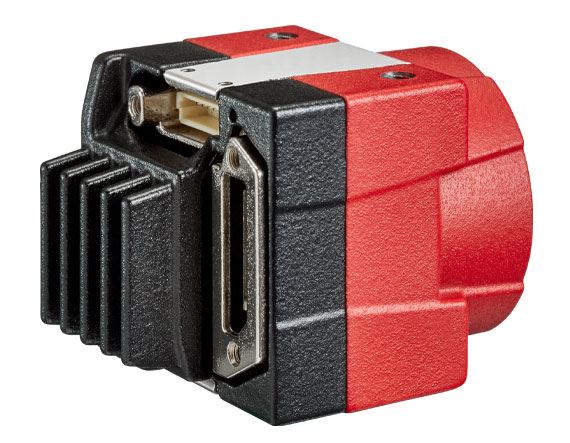Alvium 812 UV Camera
The Alvium UV 812, featuring the high-sensitivity Sony UV 8.1 MP IMX487 sensor, is capable of capturing images across the ultraviolet (UV) light spectrum range (200 to 400nm) as well as visible wavelength (400 – 700 nm). Utilizing Pregius S back-illuminated sensor technology the camera’s high sensitivity of the 200 to 400nm range opens up a world of industrial applications with greater precision in transparent materials (plastic and PET), semiconductor inspection, material sorting and more.
Image control: Auto
- Auto exposure
- Auto gain
Others:
- Adaptive noise correction
- Binning
- Black level
- Contrast
- Custom convolution
- DPC (defect pixel correction)
- FPNC (fixed pattern noise correction)
- Gamma
- LUT (look-up table)
- Reverse X/Y
- ROI (region of interest)
- Sharpness/Blur
Camera control
- Acquisition frame rate
- Bandwidth control
- Counters and timers
- Firmware update in the field
- I/O and trigger control
- Sequencer
- Serial I/Os
- Temperature monitoring
- U3 Power Saving Mode
- User sets
Alvium UV Camera QE Curve

Alvium 1800 U-812 UV Data Sheet
Alvium UV Camera Software
VIMBA X SDK
Vimba X in a nutshell:
-
- Vimba X runs on Windows 10 and 11, Linux, Linux ARM, and macOS (all 64-bit)
- GigE, USB, and CSI-2 transport layers
- C, C++, and Python APIs
- Image Transform library
- Viewer
- NEW: Vimba X Viewer contains a Sequencer tab to ease sequencing with Alvium cameras
Platform independent
Vimba X was tested with:
- Windows: Windows 11 23H2, Windows 10 21H2 LTSC (min requirement: PC or laptop with 64-bit x86 processor or better)
- Linux: Ubuntu 22.04.3 LTS, Debian 12.2 (min requirement: PC or laptop with 64-bit x86 processor or better)
- ARM64: NVIDIA JetPack 5.1.0 (L4T 35.1.0) on AGX Orin Developer Kit (min requirement: ARM board with ARMv8-compatible 64-bit processor)
- MacOS: macOS Sonoma 14.1.1 (compatible hardware: Mac mini with M2 chip, MacBookPro with M2 chip)
To operate Alvium CSI-2 cameras on your vision system, Allied Vision provides different access modes:
- GenICam for CSI-2 Access controls the camera by GenICam features, using the Alvium CSI-2 driver and CSI-2 transport layer (TL) directly.
- Direct Register Access (DRA) to control the cameras via registers for advanced users.
- Video4Linux2 Access allows to control the cameras via established V4L2 API and applications like GStreamer and OpenCV.
The CSI-2 transport layer contained in Vimba X can be used with several ARM boards / SOMs and drivers available on GitHub:
• Compatible NVIDIA SOMs, JetPack versions, and the latest versions of the driver: https://github.com/alliedvision/linux_nvidia_jetson
• i.MX 8M Plus Evaluation Kit (Yocto): https://github.com/alliedvision/alvium-manifest-imx8mpevk
• AMD Xilinx Kria KV260 (Yocto): https://github.com/alliedvision/alvium-manifest-kv260
• AMD Xilinx ZCU106 Eval Kit (Yocto): https://github.com/alliedvision/alvium-manifest-zcu106
From quick prototyping to sophisticated development
Vimba provides four APIs with extensive documentation and code examples:
The Python API is perfect for a quick and easy start or for prototyping.
The C API is Vimba’s basic and easy-to-use API. It can also be used as API for C++ applications.
The C++ API has an elaborate class architecture. It is designed as a highly efficient and sophisticated API for advanced object-oriented programming including the STL (standard template library), shared pointers, and interface classes. If you prefer an API with less design patterns, we recommend the Vimba C API.
The .NET API supports all .NET languages, for example, C#, C++/CLI, or Visual Basic .NET. Its general concept is similar to the C++ API.
All APIs cover the following functions:
- Listing currently connected cameras
- Controlling camera features
- Receiving images from the camera
- Notifications about camera connections or disconnections
The Image Transform Library converts camera images into other pixel formats and creates color images from raw images (debayering). While this is separated for the C and C++ API, the .NET API includes these functions. Therefore, a .NET application does not have to access the Image Transform Library. The APIs use GenICam transport layer (GenTL) libraries to communicate with the cameras.
Third-party libraries compatibility
Vimba’s transport layers automatically connect to third-party software, for example, LabVIEW, MATLAB, OpenCV, Halcon, CVB, µManager and more










 Lenses
Lenses